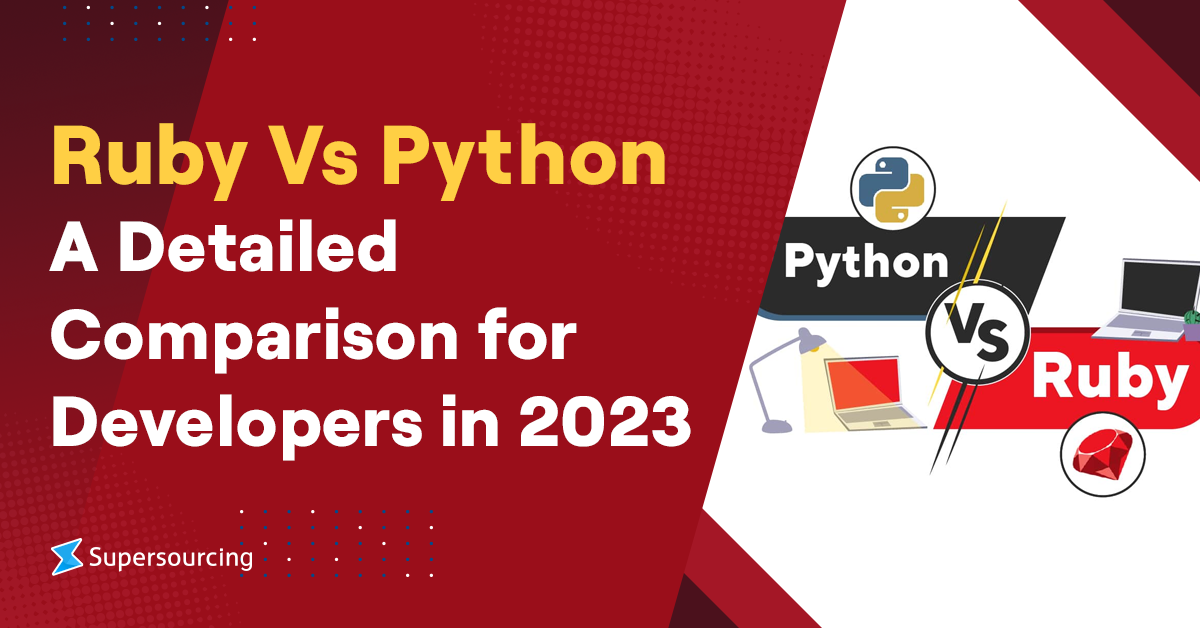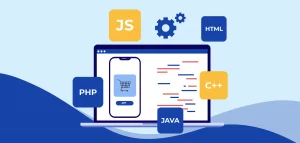Table of content
Python and Ruby are often compared in the programming world, with many debates centering around the “Ruby vs Python” topic. Both high-level, object-oriented programming languages prioritize simplicity and speed of execution over syntax correctness and strict hierarchy. Both languages provide an interactive shell, standard libraries, and multiplatform support for various operating systems, as well as persistence support. They are also popular for web development, with Django for Python and Rails for Ruby being two popular purpose-built web frameworks.
However, Ruby on Rails is more popular for web development, while Python is more popular in the academic and scientific arenas. Despite some similarities, Python and Ruby have their differences and passionate supporters, leading to flame wars. An objective assessment of each language’s strengths and weaknesses is necessary to determine which language is more suitable for a particular use case.
What is Python?
Python is a high-level, object-oriented programming language with dynamic semantics that is widely used for server-side web development, software development, mathematics, and system scripting. It has a reputation as a beginner-friendly language because it handles much of the complexity for the user, allowing beginners to focus on programming concepts.
Python is also known for its easily learned syntax and emphasis on readability, which reduces program maintenance costs. It has numerous use cases, such as creating web applications, building workflows, connecting to databases, processing big data, and developing production-ready software. Python also enables backend web development, data analysis, artificial intelligence, and scientific computing.
Many global giants are using Python actively. LinkedIn is a combination of social networks and job boards, and Flask played a role in its creation. Netflix uses Python for running tests and maintaining its tech stack. Python is one of the three core languages that Google uses, although the specifics of its usage are not clear.
What is Ruby?
Ruby is a general-purpose programming language that is open-source and can be used for various tasks like web development, data processing, automation and more. It is highly portable and can be used on every operating system. Ruby is a dynamic type language with a minimalist syntax that is similar to Python. Instead of brackets or other symbols to define code blocks within a script, it uses spacing to organize code.
Ruby on Rails employs the Model-View-Controller (MVC) pattern, a widely used architectural pattern in web development. This pattern divides the code of a web application into three interconnected parts: the Model, which stores the application’s data structure; the View, which presents the visual part of the web application as web page templates; and the Controller, which connects the Model and View, and manages the business logic of the application. This approach enables Rails to be flexible and suitable for various web application types.
Rails is capable of building full-stack web applications and web services, and its View generates the web pages that the user sees in the browser. The Model and Controller components make up the back end, while the View takes care of the front end. Additionally, Rails allows for creating web services or APIs that can return JSON for use in other applications.
GitHub, Couchsurfing, and Soundcloud are three websites that have adopted Ruby on Rails for their web development needs. GitHub uses Ruby for scalability, Couchsurfing’s tech stack relies on Ruby, and Soundcloud utilizes Ruby for their API wrapper.
Advantages of Using Ruby
- Ruby’s main advantages are its productivity-related features and dynamic ability
- It is elegant and simple, making it a popular choice for beginner programmers
- More organized and object-oriented than other languages like Perl and Python
- The metaprogramming feature makes coding even easier by auto-writing code for developers
- Despite being an interpreted language, Ruby can still save time in development, especially when used with the popular web framework, Ruby on Rails.
- Ruby on Rails can help developers build applications up to 40% fast
Advantages of Using Python
- Simple and versatile, making it a popular language for a wide range of purposes
- Extensive third-party modules and libraries simplify adding features and functionality to a program
- The syntax is easy to read and write, and it takes fewer lines of code to accomplish tasks than in some other languages
- Highly portable and can run on various operating systems without code changes
- User-friendly data structures like lists and dictionaries in Python make coding more productive and allow developers to focus on problem-solving.
Ruby Vs Python: A Detailed Comparison
Web/Web App Development
Python and Ruby compete in web development, with Ruby being dominant thanks to Ruby On Rails. Rails is flexible and allows multiple approaches to flourish, making it valuable for web developers. Python has its own unique tricks, including speed and a large ecosystem. While there is a perception that Python is faster, Ruby has become much faster and now performs just as well in benchmarks. The Ruby community is aiming for even greater speed with Ruby Version 3, and the battle between the two languages continues.
Community Support
Python has a much larger community than Ruby, with an estimated 8.2 million developers worldwide, compared to Ruby’s 1.8 million. Python’s community is more diverse and spans various areas, while Ruby’s community is smaller but passionate. Python’s community benefits from cross-pollination, while Ruby’s community is tight-knit. In terms of numbers, Python beats Ruby, with more stars, forks, watchers, and contributors on GitHub. However, Ruby’s flexibility and unique features have made it popular among its niche community.
ML & Data Science
Python dominates the field of data science and machine learning, making it the top choice for developers and businesses. Ruby, on the other hand, is not even in the top 5 languages for machine learning. Python’s early lead, community, simplicity, and general-purpose compatibility have made it the preferred language for these fields. Despite other languages being purpose-built for data science, Python remains the heavy favorite for heavy-duty machine learning projects.
Ecosystem
Python and Ruby have comprehensive ecosystems with libraries for a wide range of applications. Ruby has Rails, Sinatra, and Puma for web development, while Python has Django and Flask. In data science, Python dominates with libraries like Numpy, Pandas, and TensorFlow, and its user adoption is increasing among developers. Both communities have similar approaches to open-source software distribution.
Coding Idioms
Ruby and Python are dynamic, interpreted programming languages that share many similarities. Both use white space and lack braces and can support procedural, imperative, functional, and object-oriented paradigms. While there are subtle differences in coding idioms driven by philosophical differences, the two languages are highly versatile and can have similar applications. Ruby tends to be more expressive and similar to functional languages like Lisp or Scheme, while Python is known for its simplicity. Despite these differences, the two languages share many syntactical and other similarities.
Conclusion
The two programming languages have distinct principles. Ruby emphasizes on empowering developers with the freedom to explore without restrictions, whereas Python prioritizes simplicity and having only one right approach to problem-solving. As a result, the two communities have different cultures. Python developers tend to prefer stability and are more conservative, with a slower pace of updates and feature additions. In contrast, Ruby enthusiasts thrive on change and liberty. For instance, the Rails framework is continually evolving, and some of the improvements and features tested in Python are first experimented with in Ruby.







